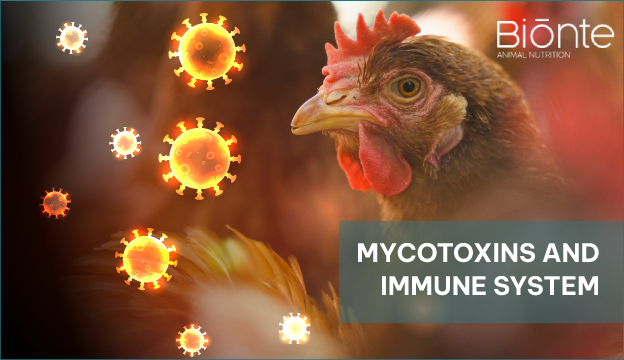The effect of mycotoxins on the immune system of animals will be described below.
Swine
In swine, susceptibility to mycotoxins is reflected in pathological findings and low productivity. The effect of mycotoxins on the immune system of pigs varies according to the toxin and the conditions present at the time of exposure.
In swine, it has been observed that aflatoxins are capable of deregulating antigen presentation mediated by dendritic cells when exposed to low concentrations. Additionally, these toxins can compromise the synthesis of pro-inflammatory cytokines. In growing piglets, there is a high susceptibility to aflatoxin B1, as it reduces the overall lymphoproliferative response. Studies have shown that when sows are exposed to this type of mycotoxin, the macrophages and neutrophils of piglets also lose certain functional capabilities (Pierron et al., 2016).
Trichothecenes such as DON and T-2 toxin can both up and down-regulate immune functions (Pierron et al., 2016). The literature asserts that deoxynivalenol suppresses the immune system when found at high concentrations and, conversely, stimulates the immune system at low concentrations (Muratori & Woo, 2021). According to this, a study conducted in pigs showed that chronic consumption of DON in contaminated diets increases the expression of inflammatory cytokines and generates a greater amount of IgA and IgG antibodies (Pestka et al., 2004). Regarding the T-2 toxin, it can cause leukopenia and a decrease in the number of lymphoid organ cells in pigs. At the same time, prolonged exposure to low doses of T-2 toxin influences memory T lymphocytes, generating an adverse effect on humoral response mediated by B lymphocytes and causing a deficient secondary immune response (Adhikari et al., 2017).
Other toxins with great influence on the immune system are fumonisins and, to a lesser extent, ochratoxin A. In swine, fumonisin B1 modifies the balance of Th1 and Th2 cytokines, altering the humoral response. Additionally, exposure to FB1 significantly reduces the number of viable cells through the process of apoptosis or cell death (Zhu et al., 2022). Several studies report that fumonisin B1 alters the maturation of antigen-presenting cells by reducing the expression of IL-12 p40 at the intestinal level and decreasing positive expression of the major histocompatibility complex class II, which reduces T-cell stimulation (Pierron, et al., 2016). Ochratoxin A in pigs has an impact on cytokine expression rather than on the total and specific immunoglobulin concentrations (Pierron et al., 2016).
Regarding zearalenone, it is better known for its toxic effect on fertility than on immunity, and information is scarce (Zakil et al., 2012). However, a study confirmed that the pig immune response is inadequate when exposed to zearalenone and its derivatives, highlighting that the toxin decreases immune cell viability, antibody formation, and cytokine production (Marín et al., 2011).
As seen above, the swine immune system changes its response to toxicity depending on the type of mycotoxin, toxin dose, and other related factors. Therefore, the variety of results differs between the stimulating or immunosuppressive effect of the mycotoxin. It can be deduced that, for both immunity results, the immune cells, cell signaling pathways, and inflammatory mediators are always altered (Cimbalo et al., 2020).
Poultry
Despite being studied for more than 50 years, the mechanisms of immunosuppression caused by aflatoxicosis are still not well understood. It is known that in the starter stages of exposure to this toxin, the humoral immune response of birds increases noticeably. However, humoral immunity decreases as the exposure period lengthens. It is presumed that aflatoxins, especially B1, deplete the number of lymphoid cells present in the thymus, spleen, and bursa of Fabricius. This inhibits the synthesis of antibodies by lymphocytes, leading to the aforementioned immune suppression (Yunus et al., 2011).
DON is characterized by inhibiting the biosynthesis of proteins, RNA, and DNA, not to mention its effect on altering cell membranes. Tissues with high protein turnover are the most affected by the exposure to DON, and the immune system is one of these tissues. Information on immunotoxicity by DON in poultry is still quite limited. In chickens, DON along with other trichothecenes can stimulate or impair humoral immunity (Awad et al., 2013). The use of serum antibody titers against common viral vaccines is often useful in understanding the effect of DON on humoral immunity. It has been identified that DON suppresses the post-vaccination response to viruses such as infectious bronchitis virus (IBV) or Newcastle disease virus (NDV) (Ghareeb et al., 2012). Recent studies suggest that DON may have an effect on the reduction of IgA and spleen weight.
Other studies conducted in chickens concluded that exposure to DON results in an increase in antibody response, although the immune response changes depending on the concentration of mycotoxins and the manifestation of other variables (Hwan et al., 2015). Additionally, in laying hens, DON has been found to reduce the total number of white blood cells and lymphocytes (Awad et al., 2013).
Regarding the T-2 toxin, it causes a lower immune response in birds because it reduces the number of lymphoid cells located in bone marrow, thymus, and spleen, allowing pathogens to become more resistant during infections. With cellular decline, various lymphoid organs lose their original size, including the bursa of Fabricius in birds (Filazi et al., 2017).
Finally, other mycotoxins have a certain impact on the avian immune system, although at a lower level. For example, ochratoxin A is capable of reducing the size of immune organs such as the thymus and bursa of Fabricius. Meanwhile, fumonisin B1 alters the morphology and functionality of macrophages, making chickens more susceptible to bacterial infections. Deficiencies in antibody titers are also observed (Hwan et al., 2015).
Ruminants
In ruminants, mycotoxins interfere with the immune function in different ways. On the one hand, they can alter cell-mediated immunity (reducing phagocytosis) and, on the other hand, impair humoral immunity. With immune dysfunction, the risk of disease increases, especially during stressful periods such as calving or weaning. It should be noted that transition cows and calves are most susceptible to the immunosuppressive effects of mycotoxins, rather than mature cows (Gott et al., 2021).
Due to the toxin degradation capacity present in the rumen, a large part of mycotoxins do not have the same effect observed in monogastric animals. However, aflatoxins are partially degraded into a metabolite known as Aflatoxicol. The toxic effect of the metabolite acts based on different mechanisms in the livestock immune system, which includes inhibiting lymphocyte blastogenesis and suppressing lymphocyte proliferation (mainly mediated by AFB1). Finally, it is emphasized that chronic exposure to mycotoxins in ruminants interferes with the immunity provided by vaccines (Bola, 2017).
Pets
In companion animals, both dogs and cats suffer from the immunosuppressive effect of mycotoxins. There is little information about mycotoxin contamination in dog and cat food formulations, and the effect of these toxins remains an unexplored field. Currently, it is understood that prolonged consumption of contaminated food has consequences for the health of dogs and cats, and their immune system is left in suboptimal conditions (Grandi et al., 2019). In dogs, the most reported and problematic group of mycotoxins are aflatoxins, as they are quite susceptible, as are pigs (Barth et al., 2013). Another described mycotoxin is ochratoxin, which has had repercussions on low resistance to infections, leaving the animal’s overall health exposed (Koerich et al., 2012).




